 Density functional theory (DFT) is the method of choice for fast calculations of ground state properties, often with excellent accuracy. Standard approximations, however, lack reliability for some of the most interesting and technologically relevant materials. To compute ground and excited state properties of a wide variety of complex systems, we therefore draw upon state-of-the-art, first-principles DFT and many-body perturbation theory methods. The GW and GW+BSE approximations are particular areas of focus because they allow for the calculation of spectroscopic properties that can readily be compared with results from photoemission and -absorption experiments.
Density functional theory (DFT) is the method of choice for fast calculations of ground state properties, often with excellent accuracy. Standard approximations, however, lack reliability for some of the most interesting and technologically relevant materials. To compute ground and excited state properties of a wide variety of complex systems, we therefore draw upon state-of-the-art, first-principles DFT and many-body perturbation theory methods. The GW and GW+BSE approximations are particular areas of focus because they allow for the calculation of spectroscopic properties that can readily be compared with results from photoemission and -absorption experiments.
One-shot G0W0 calculations, in which quasiparticle eigenvalues are computed by constructing a zeroth-order Green's function G0 and screened Coulomb interaction W0 based on a prior (generalized) Kohn-Sham DFT calculation, are particularly useful because of a good cost vs. accuracy balance as compared to fully-selfconsistent GW approaches. However, large and system-dependent starting point dependence impedes the predictive power of G0W0 for some material classes. In recent work, we showed that some halide perovskites are particularly affected by this problem. Hybrid functional starting points can lead to better agreement with experiment in these cases, but dramatically increase the computational effort of the calculations.
In ongoing projects, we are developing methods for deriving computationally less expensive but reliable starting points for complex energy materials like the halide perovskites. We are also exploring the potential of GW combined with the BSE approach for biological light-converting systems such as the photosynthetic pigments chlorophyll and bacteriochlorophyll.
Recent papers:
- L. Leppert, T. Rangel, J. B. Neaton, Towards predictive band gaps for halide perovskites: Lessons from one-shot and eigenvalue self-consistent GW, Phys. Rev. Materials 3, 103803 (2019).
